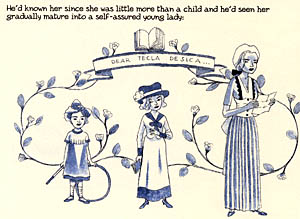 By Igort
By Igort
32 pages, two-color
Published by Fantagraphics Books
Sometimes, it’s good to be patient. That’s what immediately leapt to my mind this summer when Fantagraphics Books (in association with Coconico Press) released Baobab #3, part of their Ignatz Series line. Created by Ignatz Series founder Igort, it’s been two years since the last issue, and my first inclination was if I’d waited this long for another installment, maybe I should just wait out a few additional years for an inevitable graphic novel collection. All it took was one quick glance at the comic, though, and I realized that two years was a long enough wait.
It’s 1914, and in Japan, Hiroshi’s grandmother nears death. Meanwhile, in the South American nation of Parador, civil unrest threatens the city of Papassinas as Celestino continues to create comics for the Papassinas Echo newspaper. When the Echo is burnt to the ground, though, it places Celestino and everyone else connected with the newspaper at an important crossroads—give up their dreams, or put themselves in harm’s way and speak out?
 I must admit that after three issues, I’ve yet to see the connection between Hiroshi in Japan, and Celestino in Papassinas; with nothing evident in 96 pages, it makes me wonder just how long the completed Baobab will be. Taken on its own, though, the story of Celestino has certainly built over the past three issues, but it’s in Baobab #3 where I really feel like Igort is firing on all cylinders here. Celestino’s love for Tecla, the newspaper publisher’s daughter, adds an extra layer of interest to his character and it makes his character come to life that much more. I suspect that’s anything but coincidental; Celestino seems to have been drifting through most of the first two issues, a little oblivious to the world around him, but this extra focus has pushed him into a much stronger story. On the other hand, after the first issue giving us such a strong look into Hiroshi’s life in the Chiba prefecture of Japan, I feel like we really haven’t seen much of him since then. It makes me feel like as Celestino’s story is made stronger in Baobab, it’s at the expense of Hiroshi’s, lost almost entirely in this issue if it hadn’t been for the cover reminding us that he’s still there. With no Hiroshi at all in the second issue and just 9 pages here, it makes me wonder if Igort has lost interest in one of his two creations for this comic.
I must admit that after three issues, I’ve yet to see the connection between Hiroshi in Japan, and Celestino in Papassinas; with nothing evident in 96 pages, it makes me wonder just how long the completed Baobab will be. Taken on its own, though, the story of Celestino has certainly built over the past three issues, but it’s in Baobab #3 where I really feel like Igort is firing on all cylinders here. Celestino’s love for Tecla, the newspaper publisher’s daughter, adds an extra layer of interest to his character and it makes his character come to life that much more. I suspect that’s anything but coincidental; Celestino seems to have been drifting through most of the first two issues, a little oblivious to the world around him, but this extra focus has pushed him into a much stronger story. On the other hand, after the first issue giving us such a strong look into Hiroshi’s life in the Chiba prefecture of Japan, I feel like we really haven’t seen much of him since then. It makes me feel like as Celestino’s story is made stronger in Baobab, it’s at the expense of Hiroshi’s, lost almost entirely in this issue if it hadn’t been for the cover reminding us that he’s still there. With no Hiroshi at all in the second issue and just 9 pages here, it makes me wonder if Igort has lost interest in one of his two creations for this comic.
 One of the great things about the Ignatz Series format, with its oversized dimensions and high-quality paper, is that it makes the art reproduce that much more beautifully. A smaller page size would have lost the dramatic opening splash of the tiny figure of Hiroshi amount the rows of towering trees on all sides, with the deep blues and purples giving the scene a dark and ominous look about it. The nicer paper catches the more subtle lines of Igort’s art as well; I love the illustration where he draws Tecla as a child, then teen, then adult. They’re all recognizably her, but it’s not a case of Igort drawing the same character at different heights. Igort has really envisioned his characters as human beings, growing and changing with age, and displaying such perfect emotions on their faces. That little smirk on Tecla’s face when the narrator notes that Tecla isn’t indifferent to Celestino is just so perfect, it made me almost fall in love with the character.
One of the great things about the Ignatz Series format, with its oversized dimensions and high-quality paper, is that it makes the art reproduce that much more beautifully. A smaller page size would have lost the dramatic opening splash of the tiny figure of Hiroshi amount the rows of towering trees on all sides, with the deep blues and purples giving the scene a dark and ominous look about it. The nicer paper catches the more subtle lines of Igort’s art as well; I love the illustration where he draws Tecla as a child, then teen, then adult. They’re all recognizably her, but it’s not a case of Igort drawing the same character at different heights. Igort has really envisioned his characters as human beings, growing and changing with age, and displaying such perfect emotions on their faces. That little smirk on Tecla’s face when the narrator notes that Tecla isn’t indifferent to Celestino is just so perfect, it made me almost fall in love with the character.
Part of me really wishes that Igort would speed up production on Baobab and we’d get issues at a faster rate. At the same time, though, I can’t deny that after all that wait, this is one truly beautiful book. Still, the one down-side to getting to see Baobab in small chunks is that you don’t get the immediate large, over-arching experience that the completed project promises to bring. For those with patience, though, and a love for good artwork, I do whole-heartily recommend it.
